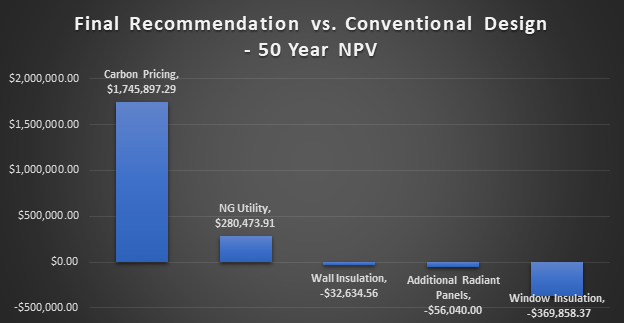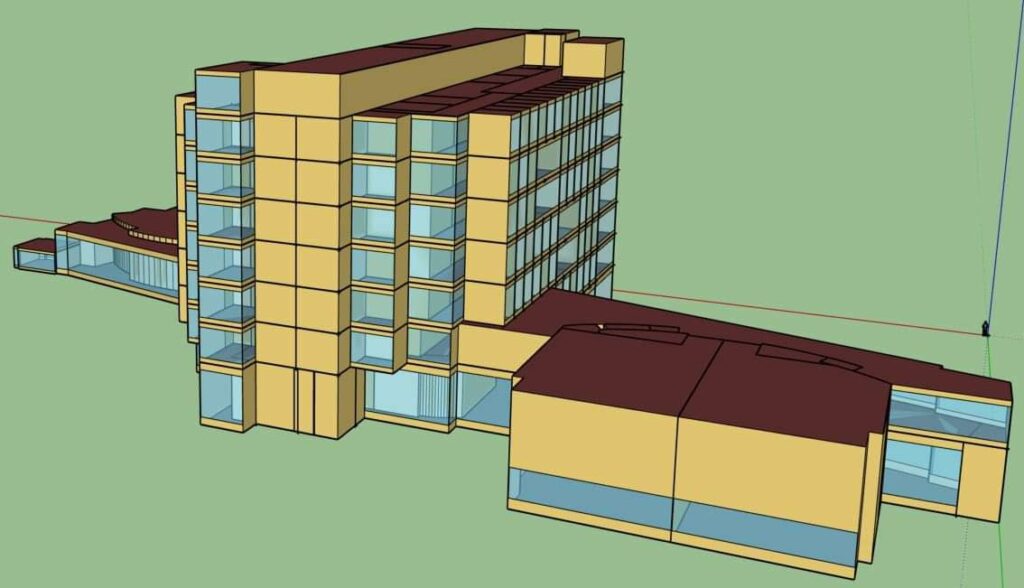Project Category: Mechanical
Join our presentation
To learn more about our project please click on the zoom link below.
We are available for questions from 10:00 am to 1:00 pm MDT
About our project
The objective of this Capstone Design Project is to design retrofitting solutions for an existing building on the University of Calgary’s main campus to prepare for LTHW district heating. LTHW district heating is the distribution of heat to commercial and residential buildings using hot supply water as low as 55°C. This allows renewable sources to be used as an energy source because the water does not need to be heated to high temperatures. Moreover, due to the lower temperature gradient between the supply water temperature and the environment, the heat losses within the system are reduced. LTHW is a feature of Fourth Generation District Heating (4GDH), which is the latest stage of districting heating that uses smart thermal grids to assist the appropriate development of sustainable energy systems.
The goal of this project is to minimize the supply water temperature within a range of 55°C-70°C of a building that is currently heated by district heating at a higher water temperature. Most importantly, this must be done while maintaining thermal comfort conditions within the building. This may be achieved by renovating existing building fittings and lowering the building energy usage by improving the building envelope. The Informations Technology and Communication (ICT) building has been selected as the primary focus for this project because it is a comparatively newer building that was constructed to be more energy-efficient making the integration of the LTHW district heating system easier.
One concern of using an LTHW system for campus buildings is that their existing coils and terminal units are sized based on higher supply water temperatures, so using LTHW may cause insufficient heat supply and less thermal comfort for patrons. At peak heat demand, ICT currently requires a supply water temperature of around 90°C.
The ultimate goal is to convert the whole campus to LTHW district heating, but this project will be a pilot project. This change is to encourage energy efficiency on campus and lower the overall heat demand. The goals of this project support the university’s 2019 Climate Action Plan (CAP) of becoming a carbon-neutral campus by 2050.
Meet our team members







Details about our design
HOW OUR DESIGN ADDRESSES PRACTICAL ISSUES
Building heating systems accounts for a substantial part of the energy consumption on campus. Therefore, the development of a more sustainable heating system such as LTHW district heating will allow the campus to transition from using fossil fuels to future sustainable energy sources.
As such, the goal of this project supports the university’s climate action plan of becoming a carbon-neutral campus by 2050. LTHW district heating allows for the integration of renewable energy and waste energy sources and reduces the heat losses in the system increasing the system efficiency. Moreover, the renovations required for the integration of LTHW make the existing buildings more energy-efficient and promote energy savings.
WHAT MAKES OUR DESIGN INNOVATIVE
Our design solution allows for the ICT building to fit the requirements of the 4GDH, which is the latest stage of district heating. This is a pilot project that the University of Calgary is starting, heading towards a carbon-neutral campus by 2050. Moreover, our design solution allows for the use of existing piping; therefore, no major re-work of the building is required.
This is an innovative design that allows for the successful integration of LTHW in the ICT building. It will lower the building heating load while ensuring thermal comfort is maintained. This solution can be installed in a relatively short period of time, allowing for minimal disruption to learning and everyday use of the building.
WHAT MAKES OUR DESIGN SOLUTION EFFECTIVE
To determine the design solution for the project, different universities that converted their campus to the LTHW system and their successful retrofit strategies were researched. Passive and active retrofit strategies were explored that can potentially be implemented in the ICT building to accommodate for LTHW district heating. The passive strategies include insulating and sealing appropriately, and the active strategies include adding additional heating units, such as radiant panels, to the critical zones.
The model was used to determine the effectiveness of each retrofit solution and if the building’s heating system functions adequately when the supply water temperature is lowered. The model results suggest that with this design solution, the ICT building can be operated at 70°C and the energy consumption has been reduced by 14.6%. Therefore, it can be confirmed that by adding the suggested retrofits, the ICT building heating system can be converted to LTHW district heating system.
HOW WE VALIDATED OUR DESIGN SOLUTION
Softwares such as SketchUp, OpenStudio and Energy Plus were used to model the ICT building. To determine the accuracy of the model, the energy consumption data provided by the model was compared to the real-life energy consumption data of the ICT building. There were no major discrepancies between the two sets of data. In addition, the results from the model met the accuracy criteria suggested by our technical advisor Dr. Simon Li. Based on this, it was concluded that the model is relatively accurate and the results can be considered valid.
Once the model was complete, the retrofit solutions were simulated. This was done by changing the specifications of heating equipment such as water temperature and flow rates and adding additional equipment, as necessary. Construction of the exterior walls was modified to mimic the effect of adding loose-fill insulation in the exposed gaps. Improvements in the window insulation were simulated by changing the North and West double pane windows to triple-pane windows. After running the simulation with the retrofit solutions, the new heating data was analyzed to see if it was more energy-efficient and if the building is still sufficiently heated.
FEASIBILITY OF OUR DESIGN SOLUTION
Economic feasibility analysis was performed to examine and investigate the investment and return on investment associated with the LTHW district heating incorporated in the ICT building. The analysis compared the performance of the ICT building as designed without LTHW district heating and the retrofitted ICT building with LTHW district heating using a 50-year net present values analysis. Sensitivity analysis was also performed to identify 70°C as the most suitable supply temperature.
The analysis shows that the LTHW district heating offers a net present value savings of $1.5 million over 50 years with a payback period of 14 years. Figure 1 shows the cumulative profit flow of our design solution. Figure 2 shows the 50-year NPV savings of our design solution compared to the conventional design.


Partners and mentors
This capstone project would not have been possible without the help of many different individuals across the University of Calgary, and we would like to take the time to thank them. We would first like to show our appreciation to our technical advisor Dr. Simon Li, professor of the Department of Mechanical and Manufacturing Engineering at the University of Calgary. We would also like to extend our thanks to Earl Badger for creating this design problem and giving us the opportunity to explore this area of study. Additionally, thank you to Brent McPherson and Dean Langham for providing us with all the necessary information on the ICT building and the building heating system and answering our many questions.
We are also grateful to the LTHW capstone group for putting in hard work all semester and completing this report. Thank you to Anam Ali, Aadrita Anjishu, David Mejia, Jasmeen Sekhon, Jeff Shin, Alexander Tran and Wei Wen Tan for all their efforts on this project over the last four months.
Finally, a special thanks to professors Dr. Simon Li and Dr. Phillip Egberts for supporting this project throughout the semester.
Our photo gallery

Informations and Communication Technology (ICT) Building Model

